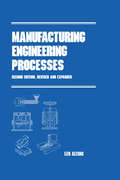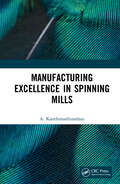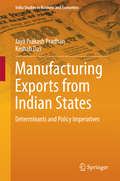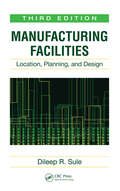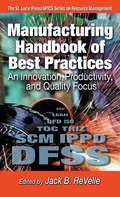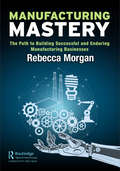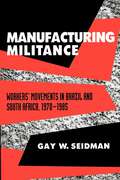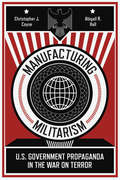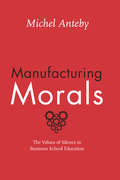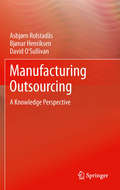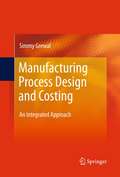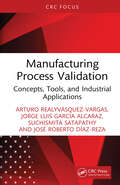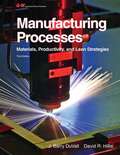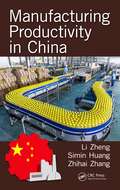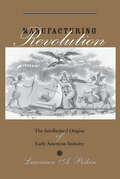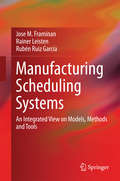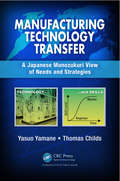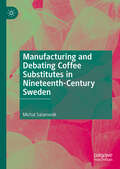- Table View
- List View
Manufacturing Engineering Processes, Second Edition
by Leo AltingResponding to the need for an integrated approach in manufacturing engineering oriented toward practical problem solving, this updated second edition describes a process morphology based on fundamental elements that can be applied to all manufacturing methods - providing a framework for classifying processes into major families with a common theoretical foundation. This work presents time-saving summaries of the various processing methods in data sheet form - permitting quick surveys for the production of specific components.;Delineating the actual level of computer applications in manufacturing, this work: creates the basis for synthesizing process development, tool and die design, and the design of production machinery; details the product life-cycle approach in manufacturing, emphasizing environmental, occupational health and resource impact consequences; introduces process planning and scheduling as an important part of industrial manufacturing; contains a completely revised and expanded section on ceramics and composites; furnishes new information on welding arc formation and maintenance; addresses the issue of industrial safety; and discusses progress in non-conventional processes such as laser processing, layer manufacturing, electrical discharge, electron beam, abrasive jet, ultrasonic and eltrochemical machining.;Revealing how manufacturing methods are adapted in industry practices, this work is intended for use by students of manufacturing engineering, industrial engineering and engineering design; and also for use as a self-study guide by manufacturing, mechanical, materials, industrial and design engineers.
Manufacturing Excellence in Spinning Mills
by A. KanthimathinathanManufacturing towards Excellence in spinning mills aims to help the relevant organization to cut costs, improve throughput, effective utilization of resources and to safeguard the interests of stakeholders. Major aspects discussed includes quality assurance, production management, maintenance management of modern machinery and laboratory equipment towards achieving manufacturing excellence with benchmarking and industry norms. Relevant case studies are provided with dedicated chapters on training and development of employees, energy management and customer focus. Explains industry norms to benchmark any spinning mill against the manufacturing performance parameters. Includes Failure Mode and Effect Analysis and Total Productive Maintenance aspects. Explores training and development standards in spinning mills. Discusses energy management and customer focus through effective techniques. Reviews SPDM, PDM Tools, Contamination index, Spin plan, Customer Satisfaction Index, Co-Creation, and HPT This book is aimed at professionals and researchers in textile engineering and management.
Manufacturing Exports from Indian States
by Jaya Prakash Pradhan Keshab DasThis book investigates the less-explored dimensions of how industries in different Indian subnational spaces or states have responded to the growing phenomenon of internationalization. What factors have influenced firms participating in global business? Have state (both central and provincial) policies acted as catalyst for local firms? Not only does this study delve into these issues; it also painstakingly develops a comprehensive database that remains unique in the absence of reliable official statistics on this subject to date. Efforts have been made to establish a reasonably consistent dataset for the period 1990-2008 derived from the CMIE-PROWESS database. Care has been taken to condense the data and classify it by sector, location, size and ownership. The study delineates export patterns by firm and state and explores factors influencing export decisions according to sector, size and location. A further interesting aspect is the book's critical examination of industrial and trade promotion policies at the state/regional level that might have contributed to or hindered exporting by firms. The states considered for detailed policy discussions are highly diverse and include Gujarat, Odisha and Karnataka. To address the glaring absence of literature on the role of subnational factors in enterprises' export performance, a preliminary state-by-state analysis of the spatial determinants of firms' export activities is also provided.
Manufacturing Facilities: Location, Planning, and Design, Third Edition
by Dileep R. SuleFierce global competition in manufacturing has made proficient facilities planning a mandatory issue in industrial engineering and technology. From plant layout and materials handling to quality function deployment and design considerations, Manufacturing Facilities: Location, Planning, and Design, Third Edition covers a wide range of topics crucia
Manufacturing Handbook of Best Practices: An Innovation, Productivity, and Quality Focus
by Jack B. ReVelleManufacturing Handbook of Best Practices: An Innovation, Productivity, and Quality Focus gives you a working knowledge of today's cutting edge tools - preparing you for the way you will be doing your job tomorrow. With contributions from seasoned manufacturing experts, the book provides a single-source reference to what's currently happening in mod
Manufacturing Ideology: Scientific Management in Twentieth-Century Japan
by William M. TsutsuiJapanese industry is the envy of the world for its efficient and humane management practices. Yet, as William Tsutsui argues, the origins and implications of "Japanese-style management" are poorly understood. Contrary to widespread belief, Japan's acclaimed strategies are not particularly novel or even especially Japanese. Tsutsui traces the roots of these practices to Scientific Management, or Taylorism, an American concept that arrived in Japan at the turn of the century. During subsequent decades, this imported model was embraced--and ultimately transformed--in Japan's industrial workshops. Imitation gave rise to innovation as Japanese managers sought a "revised" Taylorism that combined mechanistic efficiency with respect for the humanity of labor. Tsutsui's groundbreaking study charts Taylorism's Japanese incarnation, from the "efficiency movement" of the 1920s, through Depression-era "rationalization" and wartime mobilization, up to postwar "productivity" drives and quality-control campaigns. Taylorism became more than a management tool; its spread beyond the factory was a potent intellectual template in debates over economic growth, social policy, and political authority in modern Japan. Tsutsui's historical and comparative perspectives reveal the centrality of Japanese Taylorism to ongoing discussions of Japan's government-industry relations and the evolution of Fordist mass production. He compels us to rethink what implications Japanese-style management has for Western industries, as well as the future of Japan itself.
Manufacturing Mastery: The Path to Building Successful and Enduring Manufacturing Businesses
by Rebecca MorganWhile there are those who say manufacturing is dying, it is not and will not. Without a universal vow of poverty, growing economies will only increase demand. Manufacturing in the 21st century is not a question of if -- Rather, it is a function of why, what, who, where, and how. The nature and pace of change in those factors are overwhelming many. Fear, futile resistance, and uncertainty are common. While manufacturing will not die, individual manufacturing companies will if they do not learn to thrive in this new world. This book is a dynamic guide for manufacturing leaders who want to reduce the ambiguity and overwhelming changes and develop a realistic, progressive, and responsive thinking process that enables success. It provides a business operating system framework that is the foundation for connecting the many pieces of a manufacturing business into an effective, profitable operation. The author walks through the elements, relationships, capabilities, and mutability 21st-century manufacturing requires. Executives of manufacturing companies will be better able to think about and execute viable strategies leveraging the changing economy. Essentially, manufacturing is becoming increasingly complex, as are business and socioeconomic and political realities. Rapidly evolving technology adds to the confusing environment that precludes “more of the same, better, faster and cheaper” as a workable business strategy. The tsunami of information hitting owners and leaders is overwhelming many, and it is easy to become frozen in place. Economic growth and improving standards of living require that all of this change be broken into bite-size understandable pieces that thaw the minds of executives, allowing them to assess what is best right now, and move forward. This book does not overwhelm with details and models; rather it provides thinking and examples in small chunks that enable manufacturers to develop and master skills for high-level strategic leadership in ambiguity.
Manufacturing Mastery: The Path to Building Successful and Enduring Manufacturing Businesses
by Rebecca MorganWhile there are those who say manufacturing is dying, it is not and will not. Without a universal vow of poverty, growing economies will only increase demand. Manufacturing in the 21st century is not a question of if -- Rather, it is a function of why, what, who, where, and how. The nature and pace of change in those factors are overwhelming many. Fear, futile resistance, and uncertainty are common. While manufacturing will not die, individual manufacturing companies will if they do not learn to thrive in this new world. This book is a dynamic guide for manufacturing leaders who want to reduce the ambiguity and overwhelming changes and develop a realistic, progressive, and responsive thinking process that enables success. It provides a business operating system framework that is the foundation for connecting the many pieces of a manufacturing business into an effective, profitable operation. The author walks through the elements, relationships, capabilities, and mutability 21st-century manufacturing requires. Executives of manufacturing companies will be better able to think about and execute viable strategies leveraging the changing economy. Essentially, manufacturing is becoming increasingly complex, as are business and socioeconomic and political realities. Rapidly evolving technology adds to the confusing environment that precludes “more of the same, better, faster and cheaper” as a workable business strategy. The tsunami of information hitting owners and leaders is overwhelming many, and it is easy to become frozen in place. Economic growth and improving standards of living require that all of this change be broken into bite-size understandable pieces that thaw the minds of executives, allowing them to assess what is best right now, and move forward. This book does not overwhelm with details and models; rather it provides thinking and examples in small chunks that enable manufacturers to develop and master skills for high-level strategic leadership in ambiguity.
Manufacturing Mennonites
by Janis Lee ThiessenManufacturing Mennonites examines the efforts of Mennonite intellectuals and business leaders to redefine the group's ethno-religious identity in response to changing economic and social conditions after 1945. As the industrial workplace was one of the most significant venues in which competing identity claims were contested during this period, Janis Thiessen explores how Mennonite workers responded to such redefinitions and how they affected class relations.Through unprecedented access to extensive private company records, Thiessen provides an innovative comparison of three businesses founded, owned, and originally staffed by Mennonites: the printing firm Friesens Corporation, the window manufacturer Loewen, and the furniture manufacturer Palliser. Complemented with interviews with workers, managers, and business owners, Manufacturing Mennonites pioneers two important new trajectories for scholarship - how religion can affect business history, and how class relations have influenced religious history.
Manufacturing Militance: Workers' Movements in Brazil and South Africa, 1970-1985
by Gay W. SeidmanChallenging prevailing theories of development and labor, Gay Seidman's controversial study explores how highly politicized labor movements could arise simultaneously in Brazil and South Africa, two starkly different societies. Beginning with the 1960s, Seidman shows how both authoritarian states promoted specific rapid-industrialization strategies, in the process reshaping the working class and altering relationships between business and the state. When economic growth slowed in the 1970s, workers in these countries challenged social and political repression; by the mid-1980s, they had become major voices in the transition from authoritarian rule.Based in factories and working-class communities, these movements enjoyed broad support as they fought for improved social services, land reform, expanding electoral participation, and racial integration.In Brazil, Seidman takes us from the shopfloor, where disenfranchized workers organized for better wages and working conditions, to the strikes and protests that spread to local communities. Similar demands for radical change emerged in South Africa, where community groups in black townships joined organized labor in a challenge to minority rule that linked class consciousness to racial oppression. Seidman details the complex dynamics of these militant movements and develops a broad analysis of how newly industrializing countries shape the opportunities for labor to express demands. Her work will be welcomed by those interested in labor studies, social theory, and the politics of newly industrializing regions.
Manufacturing Militarism: U.S. Government Propaganda in the War on Terror
by Christopher J. Coyne Abigail R. HallThe U.S. government's prime enemy in the War on Terror is not a shadowy mastermind dispatching suicide bombers. It is the informed American citizen. With Manufacturing Militarism, Christopher J. Coyne and Abigail R. Hall detail how military propaganda has targeted Americans since 9/11. From the darkened cinema to the football field to the airport screening line, the U.S. government has purposefully inflated the actual threat of terrorism and the necessity of a proactive military response. This biased, incomplete, and misleading information contributes to a broader culture of fear and militarism that, far from keeping Americans safe, ultimately threatens the foundations of a free society. Applying a political economic approach to the incentives created by a democratic system with a massive national security state, Coyne and Hall delve into case studies from the War on Terror to show how propaganda operates in a democracy. As they vigilantly watch their carry-ons scanned at the airport despite nonexistent threats, or absorb glowing representations of the military from films, Americans are subject to propaganda that, Coyne and Hall argue, erodes government by citizen consent.
Manufacturing Morals: The Values of Silence in Business School Education
by Michel AntebyCorporate accountability is never far from the front page, and as one of the world's most elite business schools, Harvard Business School trains many of the future leaders of Fortune 500 companies. But how does HBS formally and informally ensure faculty and students embrace proper business standards? Relying on his first-hand experience as a Harvard Business School faculty member, Michel Anteby takes readers inside HBS in order to draw vivid parallels between the socialization of faculty and of students. In an era when many organizations are focused on principles of responsibility, Harvard Business School has long tried to promote better business standards. Anteby's rich account reveals the surprising role of silence and ambiguity in HBS's process of codifying morals and business values. As Anteby describes, at HBS specifics are often left unspoken; for example, teaching notes given to faculty provide much guidance on how to teach but are largely silent on what to teach. Manufacturing Morals demonstrates how faculty and students are exposed to a system that operates on open-ended directives that require significant decision-making on the part of those involved, with little overt guidance from the hierarchy. Anteby suggests that this model--which tolerates moral complexity--is perhaps one of the few that can adapt and endure over time. Manufacturing Morals is a perceptive must-read for anyone looking for insight into the moral decision-making of today's business leaders and those influenced by and working for them.
Manufacturing Morals: The Values of Silence in Business School Education
by Michel AntebyCorporate accountability is never far from the front page, and as one of the world’s most elite business schools, Harvard Business School trains many of the future leaders of Fortune 500 companies. But how does HBS formally and informally ensure faculty and students embrace proper business standards? Relying on his first-hand experience as a Harvard Business School faculty member, Michel Anteby takes readers inside HBS in order to draw vivid parallels between the socialization of faculty and of students. In an era when many organizations are focused on principles of responsibility, Harvard Business School has long tried to promote better business standards. Anteby’s rich account reveals the surprising role of silence and ambiguity in HBS’s process of codifying morals and business values. As Anteby describes, at HBS specifics are often left unspoken; for example, teaching notes given to faculty provide much guidance on how to teach but are largely silent on what to teach. Manufacturing Morals demonstrates how faculty and students are exposed to a system that operates on open-ended directives that require significant decision-making on the part of those involved, with little overt guidance from the hierarchy. Anteby suggests that this model—which tolerates moral complexity—is perhaps one of the few that can adapt and endure over time.Manufacturing Morals is a perceptive must-read for anyone looking for insight into the moral decision-making of today’s business leaders and those influenced by and working for them.
Manufacturing Outsourcing
by Asbjørn Rolstadås David O'Sullivan Bjonar HenriksenAll companies which reach a critical size are faced with outsourcing decisions that can increase the value of their products and services primarily through lower costs, greater reliability and improved efficiency. Successful outsourcing decisions have an important knowledge dimension, where the outsourcing professionals need to be supported by historical and contextual knowledge regarding their own products performance but also the performance of suppliers. Outsourcing in Manufacturing: the Knowledge Dimension explains in detail how a manager can acquire, create, transfer and use knowledge that optimizes their outsourcing decisions and improves the changes of marketplace success. Outsourcing in Manufacturing: the Knowledge Dimension gives examples of the key decisions that needs to be taken by managers regarding effective outsourcing. Decisions are divided around the structural and infrastructural aspects of outsourcing and the key knowledge that needs to be managed to support good decisions. The book contains illustrations and examples of key processes throughout and concludes with a section dedicated to case studies. These case studies represent a variety of manufacturing system types and sizes focused on supply chain integration, and which deploy various manufacturing paradigms including craft, mass, lean, adaptive, and sustainable manufacturing. Outsourcing in Manufacturing: the Knowledge Dimension covers many theoretical and practical examples of critical outsourcing decisions, their knowledge aspects and how knowledge challenges can be dealt with in a systematic way. It provides a key resource for students, lecturers and industry managers looking to solidify their understanding and application of outsourcing decision making strategies. .
Manufacturing Performance Management using SAP OEE
by Dipankar Saha Mahalakshmi Syamsunder Sumanta ChakrabortyLearn how to configure, implement, enhance, and customize SAP OEE to address manufacturing performance management. Manufacturing Performance Management using SAP OEE will show you how to connect your business processes with your plant systems and how to integrate SAP OEE with ERP through standard workflows and shop floor systems for automated data collection. Manufacturing Performance Management using SAP OEE is a must-have comprehensive guide to implementing SAP OEE. It will ensure that SAP consultants and users understand how SAP OEE can offer solutions for manufacturing performance management in process industries. With this book in hand, managing shop floor execution effectively will become easier than ever. Authors Dipankar Saha and Mahalakshmi Symsunder, both SAP manufacturing solution experts, and Sumanta Chakraborty, product owner of SAP OEE, will explain execution and processing related concepts, manual and automatic data collection through the OEE Worker UI, and how to enhance and customize interfaces and dashboards for your specific purposes. You'll learn how to capture and categorize production and loss data and use it effectively for root-cause analysis. In addition, this book will show you: Various down-time handling scenarios. How to monitor, calculate, and define standard as well as industry-specific KPIs. How to carry out standard operational analytics for continuous improvement on the shop floor, at local plant level using MII and SAP Lumira, and also global consolidated analytics at corporation level using SAP HANA. Steps to benchmark manufacturing performance to compare similar manufacturing plants' performance, leading to a more efficient and effective shop floor. Manufacturing Performance Management using SAP OEE will provide you with in-depth coverage of SAP OEE and how to effectively leverage its features. This will allow you to efficiently manage the manufacturing process and to enhance the shop floor's overall performance, making you the sought-after SAP OEE expert in the organization. What You Will Learn Configure your ERP OEE add-on to build your plant and global hierarchy and relevant master data and KPIs Use the SAP OEE standard integration (SAP OEEINT) to integrate your ECC and OEE system to establish bi-directional integration between the enterprise and the shop floor Enable your shop floor operator on the OEE Worker UI to handle shop floor production execution Use SAP OEE as a tool for measuring manufacturing performance Enhance and customize SAP OEE to suit your specific requirements Create local plant-based reporting using SAP Lumira and MII Use standard SAP OEE HANA analytics Who This Book Is For SAP MII, ME, and OEE consultants and users who will implement and use the solution.
Manufacturing Process Design and Costing
by Simmy GrewalThe only book to provide detailed analytical tools for manufacturing process design. No other book takes a data perspective to design, although this becoming a hot topic in research and industry.
Manufacturing Process Validation: Concepts, Tools, and Industrial Applications
by Arturo Realyvásquez-Vargas Jorge Luis García Alcaraz Suchismita Satapathy José Roberto Díaz-RezaUnlock the secrets to optimizing manufacturing processes with this essential guide to process validation. Designed for both industry professionals and academics, this book bridges the gap between theory and practice, offering a clear roadmap to enhance quality and productivity. Discover core concepts, step-by-step implementation strategies, and powerful problem-solution tools. Explore the real-world case studies that showcase how process validation transforms production lines, from data collection to actionable improvements. Whether aiming to streamline operations or achieve operational excellence, this book provides the knowledge and practical insights to drive continuous improvement.Manufacturing Process Validation: Concepts, Tools, and Industrial Applications discusses the importance of manufacturing process validation in addressing quality issues. It explores the primary tools utilized in implementing process validation within industrial settings and features two case studies demonstrating how validation can enhance production processes. Process validation is crucial in guaranteeing a process's quality and efficiency. The book goes on to emphasize the significance of collecting and evaluating data from the design phase through production to establish a process's quality and reproducibility.Designed for professionals, this resource serves as a crucial link between theoretical concepts and real-world applications. It provides a comprehensive guide for successfully implementing process validation, offering a clear and detailed roadmap for achieving optimal results.
Manufacturing Processes: Materials, Productivity, and Lean Strategies
by David R. Hillis J. Barry DuvallManufacturing Processes provides an excellent introduction to today's manufacturing processes, as well as an overview of automated manufacturing systems. The text concentrates on the five major types of industrial materials: metals, plastics, ceramics, woods, and composites. It providesthorough coverage of the forming, separating, fabricating, conditioning, and finishing processes related to each material. The text includes a chapter covering the materials and manufacturing processes used in packaging finished goods.
Manufacturing Productivity in China (Industrial and Systems Engineering Series)
by Li Zheng Simin Huang Zhihai ZhangChinese manufacturing industries continue to impact the world economy. It is important to understand what is happening in China and the uniqueness of Chinese manufacturing industries. Manufacturing Productivity in China brings together a group of authors from academia and industry to give an industrial engineering micro viewpoint instead of an econ
Manufacturing Revolution: The Intellectual Origins of Early American Industry (Studies in Early American Economy and Society from the Library Company of Philadelphia)
by Lawrence A. Peskin"While much has been written about the industrial revolution," writes Lawrence Peskin, "we rarely read about industrial revolutionaries." This absence, he explains, reflects the preoccupation of both classical and Marxist economics with impersonal forces rather than with individuals. In Manufacturing Revolution Peskin deviates from both dominant paradigms by closely examining the words and deeds of individual Americans who made things in their own shops, who met in small groups to promote industrialization, and who, on the local level, strove for economic independence.In speeches, petitions, books, newspaper articles, club meetings, and coffee–house conversations, they fervently discussed the need for large-scale American manufacturing a half-century before the Boston Associates built their first factory. Peskin shows how these economic pioneers launched a discourse that continued for decades, linking industrialization to the cause of independence and guiding the new nation along the path of economic ambition. Based upon extensive research in both manuscript and printed sources from the period between 1760 and 1830, this book will be of interest to historians of the early republic and economic historians as well as to students of technology, business, and industry.
Manufacturing Scheduling Systems
by Jose M. Framinan Rainer Leisten Rubén Ruiz GarcíaThe book is devoted to the problem of manufacturing scheduling, which is the efficient allocation of jobs (orders) over machines (resources) in a manufacturing facility. It offers a comprehensive and integrated perspective on the different aspects required to design and implement systems to efficiently and effectively support manufacturing scheduling decisions. Obtaining economic and reliable schedules constitutes the core of excellence in customer service and efficiency in manufacturing operations. Therefore, scheduling forms an area of vital importance for competition in manufacturing companies. However, only a fraction of scheduling research has been translated into practice, due to several reasons. First, the inherent complexity of scheduling has led to an excessively fragmented field in which different sub problems and issues are treated in an independent manner as goals themselves, therefore lacking a unifying view of the scheduling problem. Furthermore, mathematical brilliance and elegance has sometimes taken preference over practical, general purpose, hands-on approaches when dealing with these problems. Moreover, the paucity of research on implementation issues in scheduling has restricted translation of valuable research insights into industry. "Manufacturing Scheduling Systems: An Integrated View on Models, Methods and Tools" presents the different elements constituting a scheduling system, along with an analysis the manufacturing context in which the scheduling system is to be developed. Examples and case studies from real implementations of scheduling systems are presented in order to drive the presentation of the theoretical insights. The book is intended for an ample readership including industrial engineering/operations post-graduate students and researchers, business managers, and readers seeking an introduction to the field.
Manufacturing Servitization in the Asia-Pacific
by Jing Wang Ke Xing Michitaka KosakaThis book systematically describes the development of manufacturing servitization in the Asia-Pacific region. It offers a practical and theoretical reference guide to the manufacturing companies in the Asia-Pacific region, which is now a major global manufacturing center. Servitization is a fairly recent trend in the manufacturing industry: some American and European manufacturing companies have successfully transformed to service oriented manufacturing companies over the past three decades, while Asian-Pacific region companies have only more recently begun to recognize the importance of servitization. But some Asia-Pacific region companies have been exploring approaches in the same direction of servitization without being aware of the concept. One unique aspect of this book is the fact that it takes into consideration the social and cultural influences of this region. It introduces companies within and beyond the region, as well as the academic world, to the current state of development of the Asia-pacific manufacturing industry and its servitization trend. This is the first book that focuses on this topic, one which is of great theoretical and practical importance.
Manufacturing Technology Transfer: A Japanese Monozukuri View of Needs and Strategies
by Yasuo Yamane Tom ChildsBased on a bestselling book originally published in Japanese, Manufacturing Technology Transfer: A Japanese Monozukuri View of Needs and Strategies offers time-tested methods and little-known tips for achieving successful transfer of technology along with the skills required to operate that technology. Designed to support a series of lectures on technology transfer within a master’s course on the management of technology, it presents the results of years of research carried out at Hiroshima University.The book delves into the authors’ decades of experience transferring technology between Japan and the rest of the world, particularly to developing countries from where much of the world’s future economic growth is expected. It contains case studies of successful technology transfers from both the ship building and food equipment industries. Its wide-reaching coverage examines methods of skill transfer, production management, and manufacturing company classification.Introducing readers to the engineering activities that occur within the manufacturing industry, the book illustrates the engineering technology activities involved in manufacturing, along with the production management activities required to support them. It also explains how job simulators can help shorten learning times in the manufacturing industry in the same way that flight simulators are used to teach flying skills to pilots.The book outlines a framework for teaching and learning processes that can be visualized in terms of an S-shaped learning curve. It explains how technology transfer overseas should be supported by contractual agreements between the parties concerned. Detailing the legal/contractual responsibilities for all parties involved, it also describes what you should do if problems arise during the transfer.Integrating previously unpublished research results with illustrative case studies, this book is suitable for a wide audience within the manufacturing industry—including manufacturing engineering students in both developed and developing countries, those responsible for the development of manufacturing engineers in industry and elsewhere, and anyone interested in the international activities of Japanese manufacturing companies.
Manufacturing Technology Transfer: A Japanese Monozukuri View of Needs and Strategies
by Yasuo Yamane Tom ChildsBased on a bestselling book originally published in Japanese, Manufacturing Technology Transfer: A Japanese Monozukuri View of Needs and Strategies offers time-tested methods and little-known tips for achieving successful transfer of technology along with the skills required to operate that technology. Designed to support a series of lectures on technology transfer within a master’s course on the management of technology, it presents the results of years of research carried out at Hiroshima University.The book delves into the authors’ decades of experience transferring technology between Japan and the rest of the world, particularly to developing countries from where much of the world’s future economic growth is expected. It contains case studies of successful technology transfers from both the ship building and food equipment industries. Its wide-reaching coverage examines methods of skill transfer, production management, and manufacturing company classification.Introducing readers to the engineering activities that occur within the manufacturing industry, the book illustrates the engineering technology activities involved in manufacturing, along with the production management activities required to support them. It also explains how job simulators can help shorten learning times in the manufacturing industry in the same way that flight simulators are used to teach flying skills to pilots.The book outlines a framework for teaching and learning processes that can be visualized in terms of an S-shaped learning curve. It explains how technology transfer overseas should be supported by contractual agreements between the parties concerned. Detailing the legal/contractual responsibilities for all parties involved, it also describes what you should do if problems arise during the transfer.Integrating previously unpublished research results with illustrative case studies, this book is suitable for a wide audience within the manufacturing industry—including manufacturing engineering students in both developed and developing countries, those responsible for the development of manufacturing engineers in industry and elsewhere, and anyone interested in the international activities of Japanese manufacturing companies.
Manufacturing and Debating Coffee Substitutes in Nineteenth-Century Sweden
by Michal SalamonikThis book explores the development of coffee substitutes in nineteenth-century Sweden. In doing so, it considers the the threshold between the preindustrial and industrial periods by analyzing trade, consumption, social, economic, and environmental changes, and the Second Agricultural Revolution. By analyzing the development of coffee substitutes in Sweden, the project discovers even the social and gender norms connected to the usage of new beverages. Connecting developments in Sweden with wider European and global contexts, it provides a unique insight into the period's environmental and food histories. Finally, the book traces how reenactment takes place through growing plants and preparing historical beverages.
